Sourdough is known for its tangy flavor, chewy texture, and rustic appearance. Just because you are gluten-free doesn’t mean you have to give up this incredible homemade bread. My crusty gluten-free sourdough bread boule tastes like real artisan sourdough! I walk you through every step to make this vegan gluten-free sourdough from scratch!
This post may contain affiliate links. Please read our Disclosure Policy.
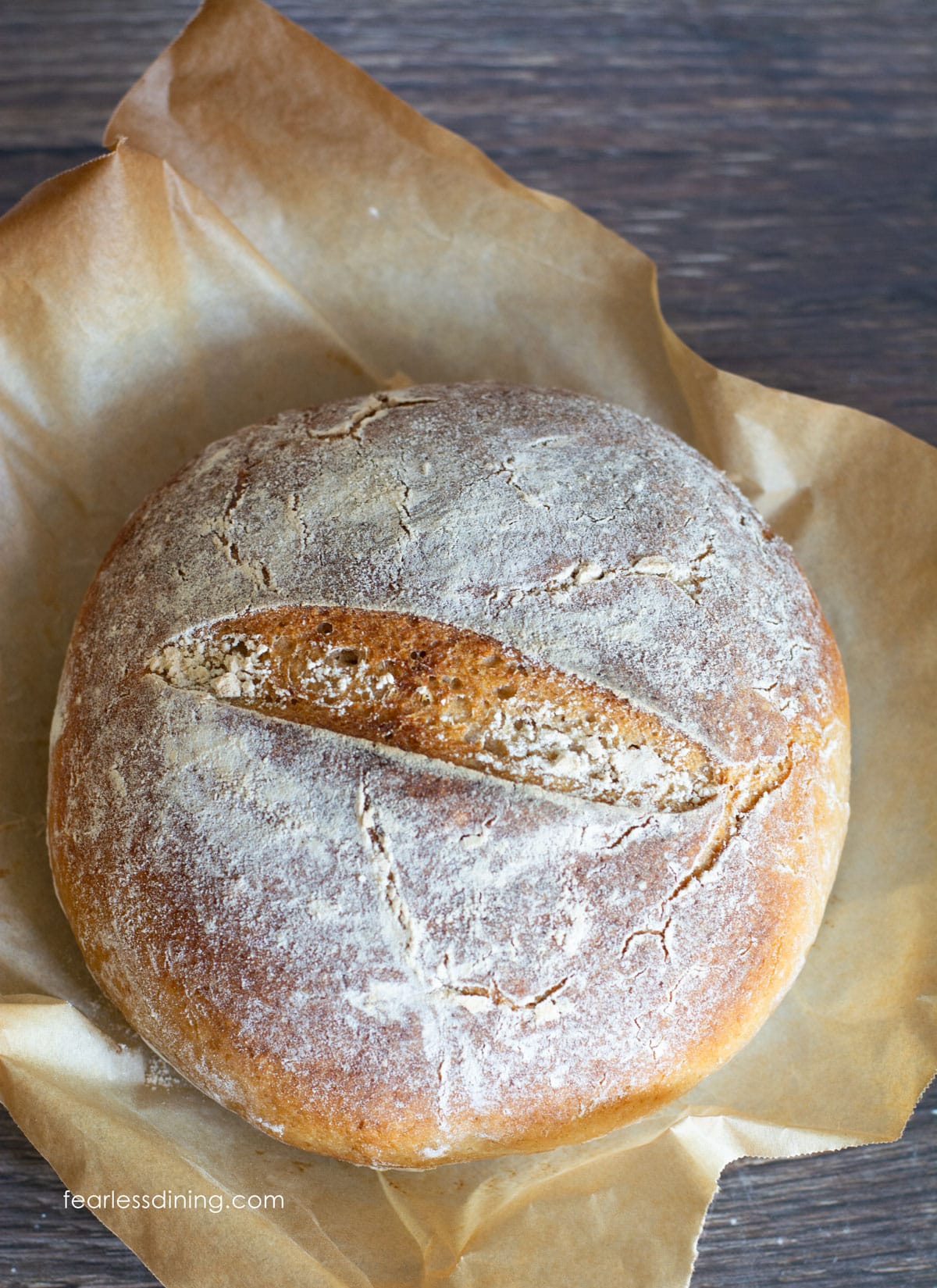
I have been on a sourdough deep dive for weeks. A few years ago, I made a sourdough starter and baked sourdough quite a bit, but I wanted to make perfect crusty gluten-free artisan sourdough. My family has been taste-testing for weeks and helping me perfect my recipe, and it is finally perfect. Stay tuned for fun flavors of sourdough boule; I already have been testing recipes out!
Struggling with gluten-free bread that collapses or turns out gummy? My Ultimate Gluten-Free Bread Guide shares the flour blends, tools, and tips that really help.
Serve this delicious bread with this Gluten-Free Fish Chowder, Ground Pork Pasta Sauce, or Kale and Apple Salad.
This is a recipe that has a ton of information. I know many readers like using the Jump to Recipe button, but I recommend reading this post in full. You can also use the Table of Contents to jump to the areas you need help with.”
sandi @fearlessdining
If you love baking, check out my easy gluten-free bread recipes. If you have some sourdough discard to use, try these Gluten-Free Sourdough Discard Muffins or these Gluten-Free Sourdough Discard Scones.
Allergen Information:
This artisan sourdough recipe is gluten-free, dairy-free, egg-free, soy-free, and nut-free. This gluten-free sourdough is 100% vegan.
This delicious gluten free sourdough with no eggs is a winner! If you are both gluten and egg-free, I have many gluten and egg-free recipes to try!
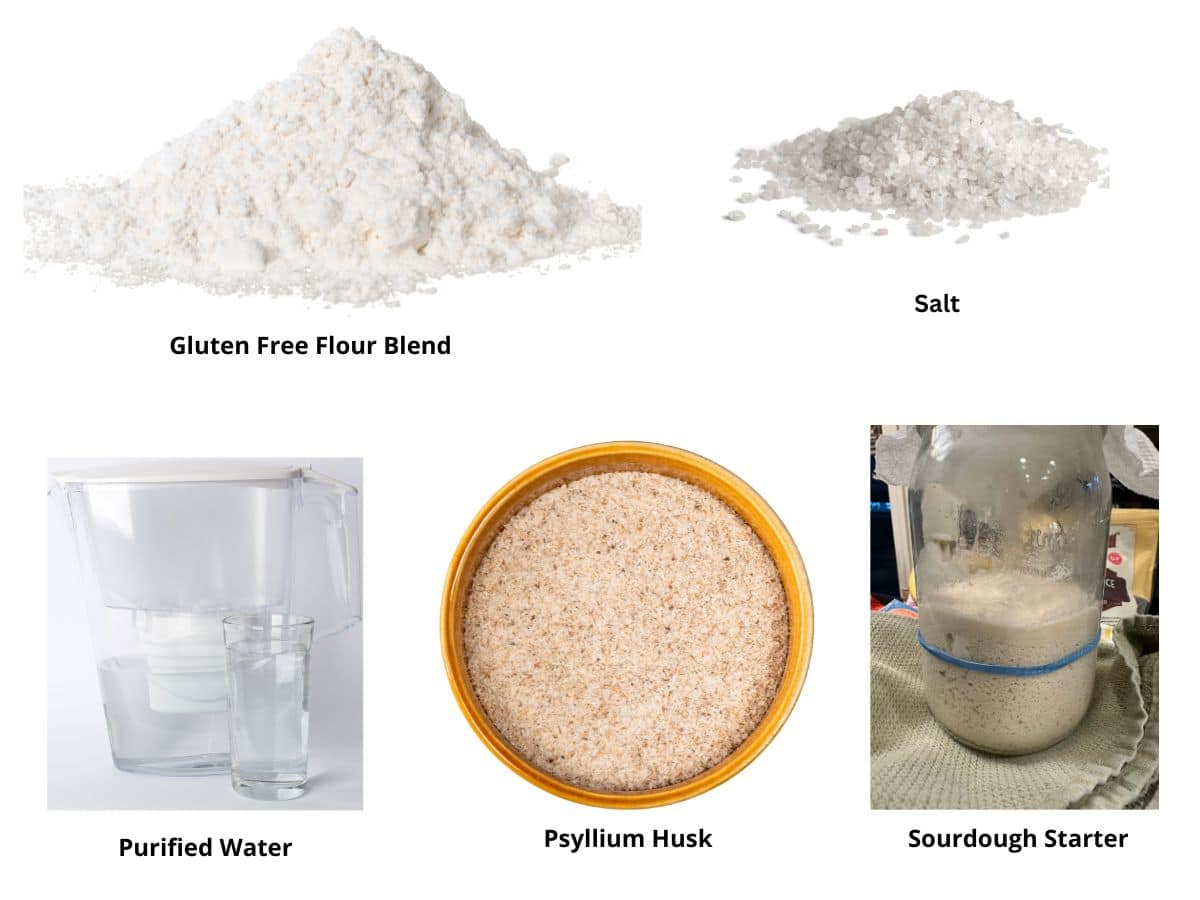
Ingredient Notes:
For the full list of ingredients and amounts, please go to the recipe card below.
A note on using flour blends when making sourdough bread: In my sourdough recipes, 1:1 blends rarely yield the same results as my custom blends. I have four easy-to-make, homemade gluten-free flour blends to choose from, and many are flexible in ingredients if you have other allergens besides gluten.
🔑 Sandi says: If you use my blends to make sourdough, it is important to omit the psyllium husk powder in my flour mix recipes. I use psyllium husks, not powder, in my sourdough recipes. Check out my gluten-free flour blend recipes.
- Gluten Free Flour Blend – I find custom blends easier to use than a 1:1 mix when making my gluten-free artisan sourdough bread. I tested this recipe with my DIY Gluten-Free All Purpose Blend, Gluten-Free Rice Free Flour Blend, Gluten-Free Sorghum-Free Flour Blend, and Gluten-Free Whole Grain Flour Blend. UPDATE 8/18/24: I tested this recipe with Namaste Gluten Free Flour Blend and it worked well. You need to add 1/4 to 1/3 cup of additional water for this blend. Start with 1/4 and add a little more as needed.
- Psyllium Husks – Use the husks and not powdered psyllium. I promise you will get a much better texture to your gluten free sourdough using the husk. This means you skip adding the psyllium powder if mixing and using my flour blends!
- Gluten-Free Sourdough Starter – My starter is named Winifred, or “Winnie” for short. If you want to read how to make your own gluten-free starter, read my Gluten-Free Sourdough Starter Tutorial. The nice thing about this tutorial is that I share how to make a starter with single flour blends, 1:1 blends, and using Cultures for Health Gluten-Free Sourdough Starter.(Winnie was made from the gluten-free Cultures For Health Starter, and she took off faster than any homemade starter I have tried.)
- Salt – I use sea salt, but kosher salt is also fine.
- Water – It is important to use purified, filtered water. Tap water has a lot of chemicals and chlorine. These can kill your yeast, affecting the rise of your bread.
Tools For Making Gluten-Free Sourdough:
- Bread Banneton – A bread banneton proofing basket is great for raising your dough. It is made with ratan and absorbs extra moisture while the dough is proofed, which will help your sourdough not be sticky. I own this banneton, but I will share directions below on how to rise the dough if you don’t own a banneton. So far, I have used this banneton 4 times. This brand has great instructions to break in the banneton and keep it clean.
- Small Dutch Oven or 10-inch Cast Iron Pan – I have made a sourdough boule with both a 4.5 quart Lodge Dutch oven and cast iron pans. I found getting steam using my Dutch oven easier, but both types work very well.
- Bread Lame – A bread lame is another inexpensive tool that is helpful in bread making. It is used to score the top of the bread so that it expands up and not out the sides.
- Digital Food Scale – I love this digital food scale by Etecity. It is inexpensive and very easy to use. It comes with a plastic bowl, which makes measuring ingredients really easy.
- Lastly, you will need a digital thermometer. This is very important so you can check the internal temperature of the bread.
For a full list, please read my Favorite Sourdough Tools article. You may also want to make this Gluten Free Cheddar Sourdough Bread.
Love, love, love! Having trouble not just eating the whole loaf!”
Terri C., email
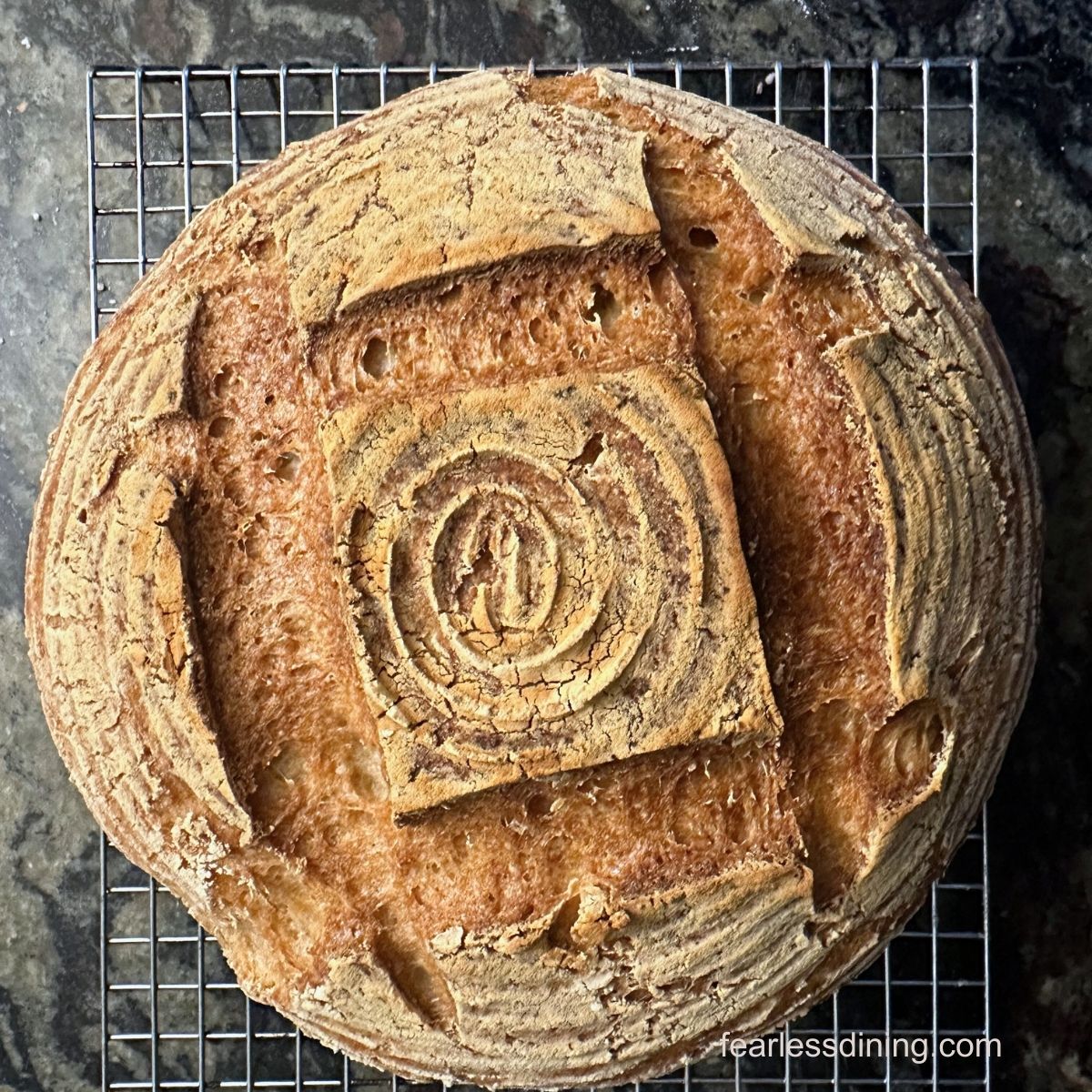
Do This First:
As I mentioned in the Ingredient Notes, if you are new to baking with sourdough, you must create a gluten-free starter. You can see my full recipe and step-by-step directions on my How To Make A Gluten-Free Sourdough Starter page. Once you have a bubbly, active, gluten-free sourdough bread starter, you can make and enjoy any of my gluten-free sourdough recipes.
- Ensure your sourdough starter is healthy and active. If you store your sourdough in the refrigerator, take it out and feed it before making bread. Let it warm to room temperature before using it.
- If the starter is not rising well or has a foul smell, consider refreshing it with equal parts flour and water and allowing it to ferment at room temperature until bubbly and active.
- If a clear liquid is on top of the starter, it is called a hooch, and you should drain it off. This hooch is a sign that your starter is hungry and needs to be fed.
How to Make a Gluten-Free Sourdough Boule (Step-By-Step)
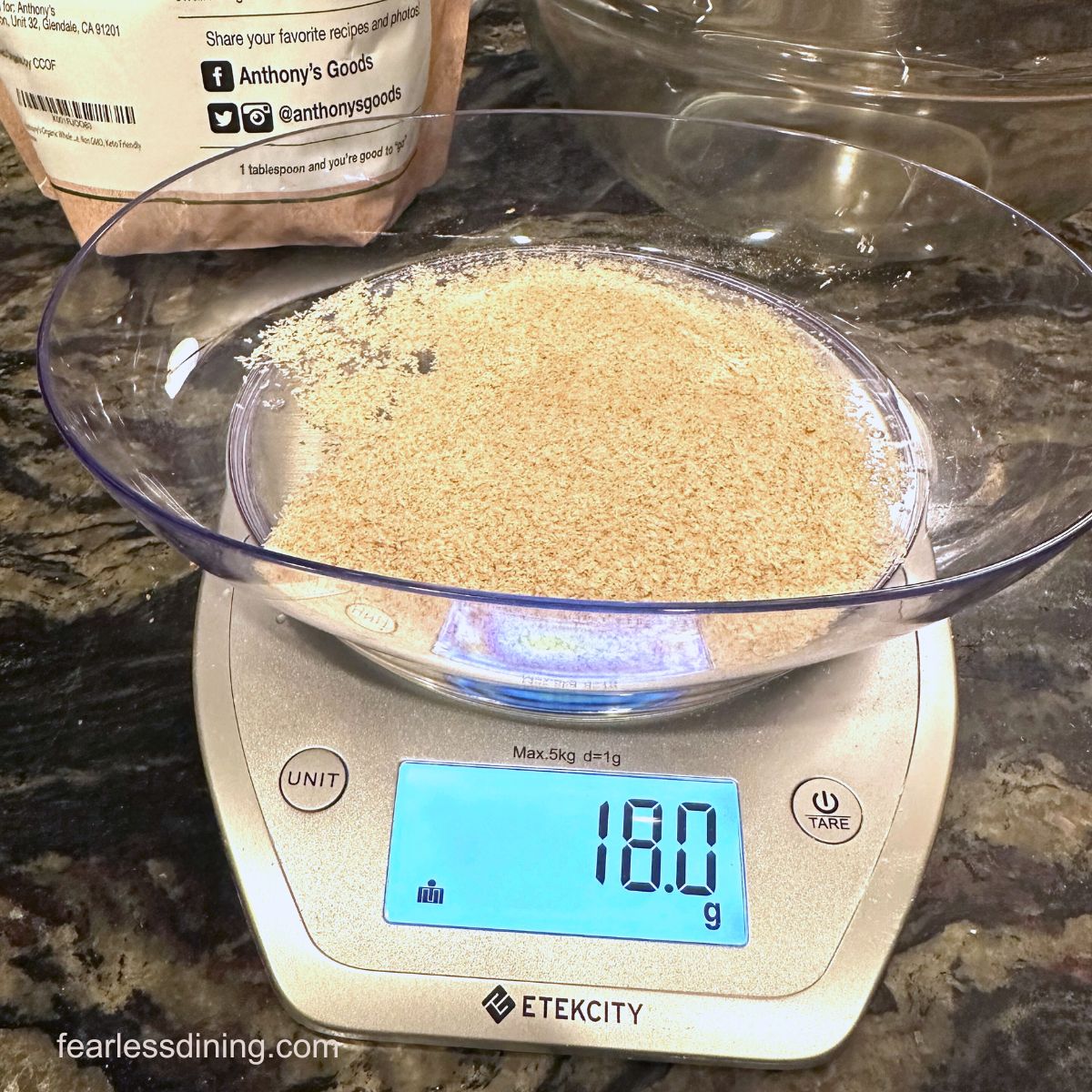
Measure 18 grams of psyllium husks on a digital kitchen scale. Place the husks into a small
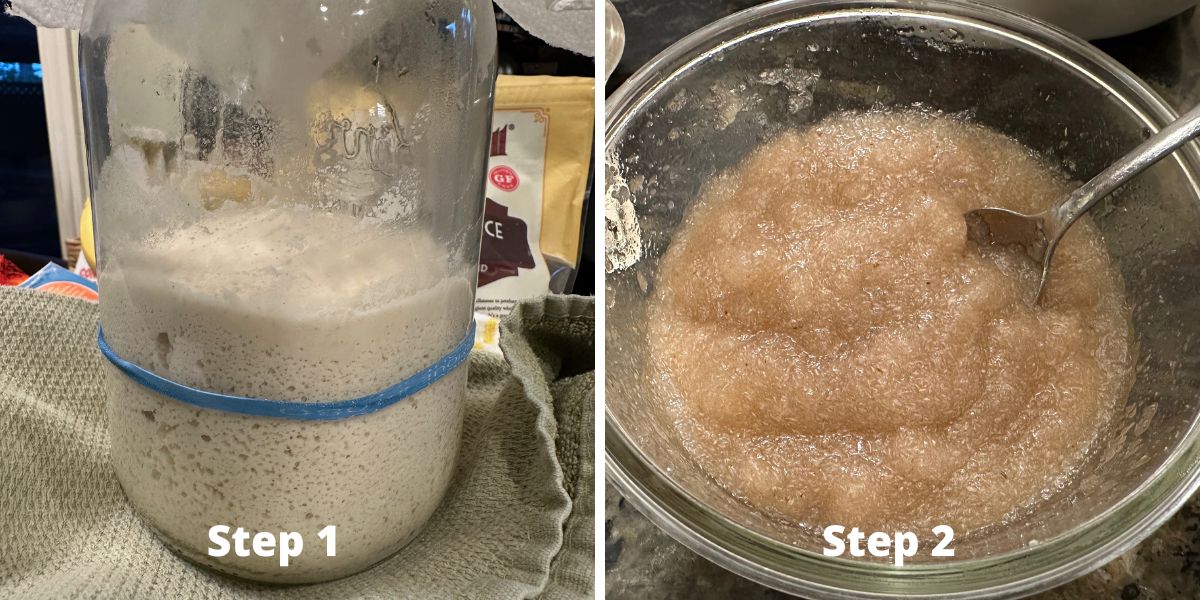
Step 1: Take your sourdough starter. I like to feed mine 3 hours before using it during the winter months, so it is nice and bubbly. I find this need varies by how warm your house is. Take out 3/4 cup of sourdough starter from your jar and set it aside.
Step 2: Pour 1 1/2 cups of warm, purified water into the bowl of husks. Use a spoon to stir it. It will form a gel in about 2-3 minutes.
Why Water Quality Is Important:
I always use purified water when making sourdough or baking with yeast. Chlorine and chemicals in our tap water can kill your yeast and inhibit the rise. If you want the best rise, you must use purified water that doesn’t contain these chemicals.
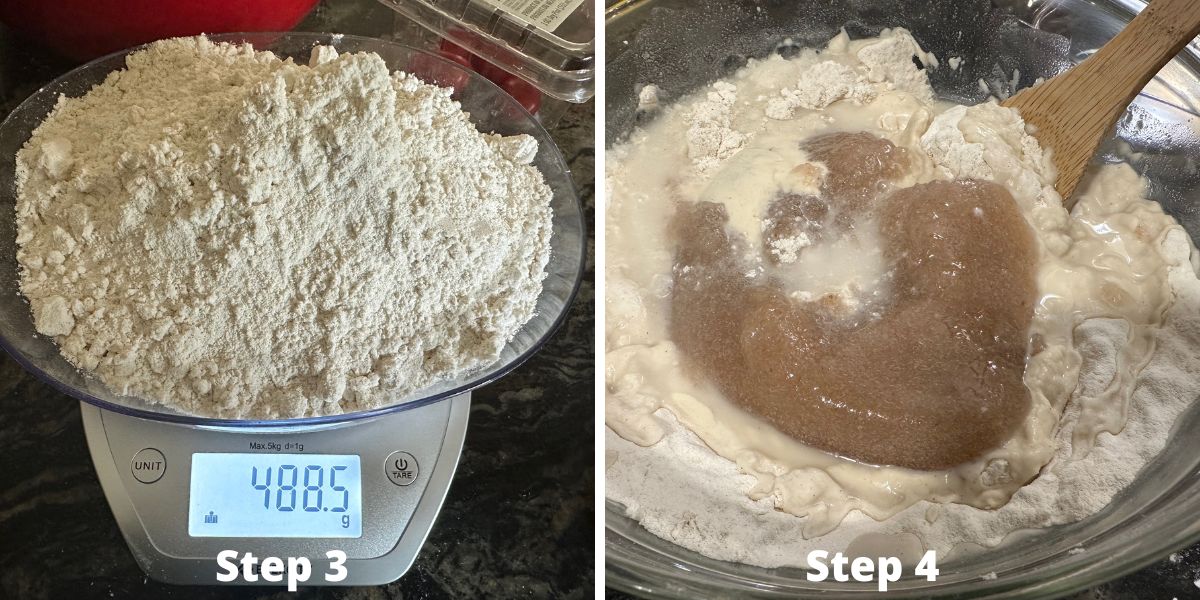
Step 3: Measure 488.5 grams of one of my gluten-free flour blends. It is important to note that every flour blend has a different starch-to-grain ratio. I have successfully tested this sourdough boule recipe with all four of my homemade gluten-free flour blends.
Add the flour to a large
Step 4: Add 3/4 cup of sourdough, the psyllium gel, and one cup of water to the flour in the bowl.
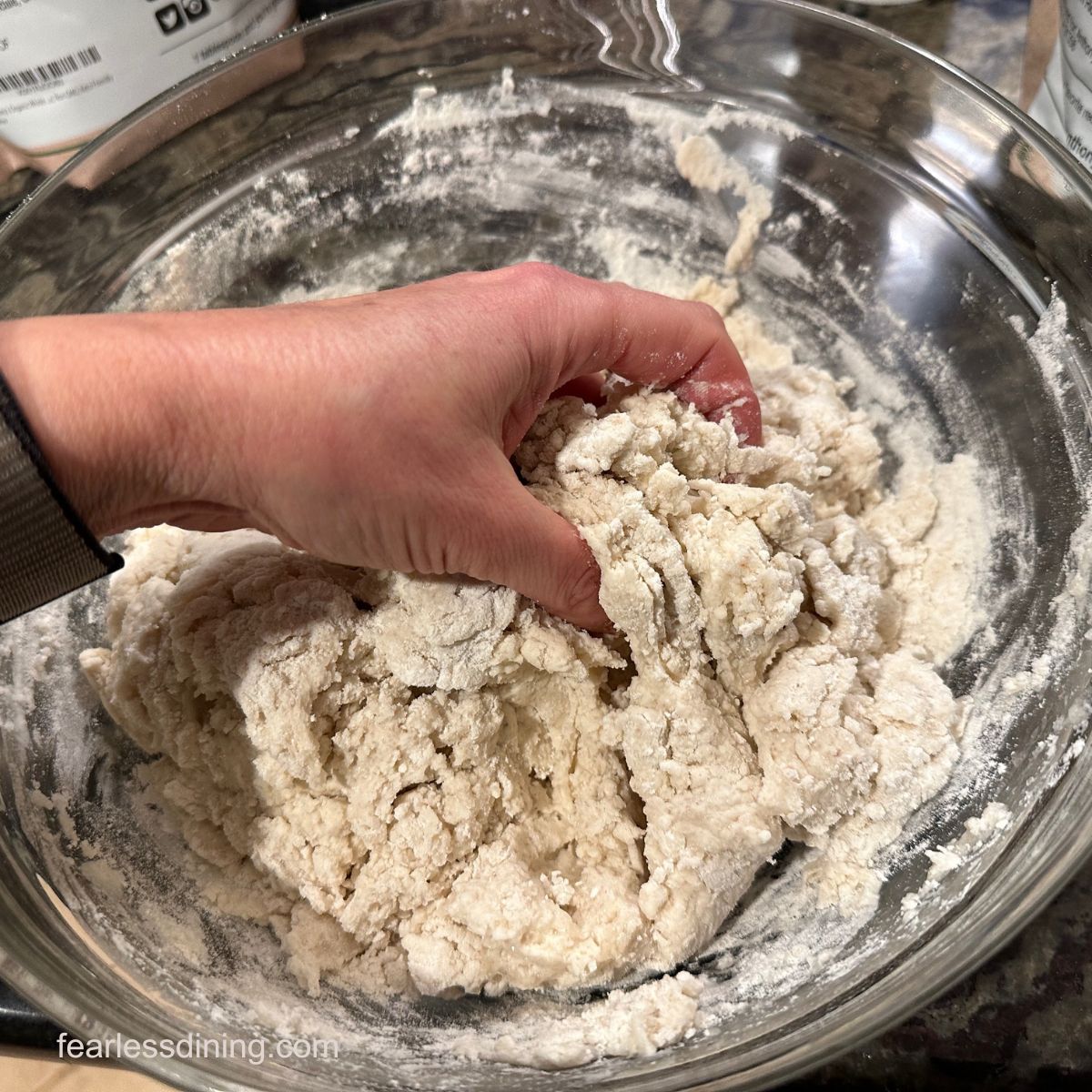
Step 5: Mix the ingredients with a large wooden spoon. Once they are mostly mixed, you will have a rough-looking dough, as shown above. Wash your hands and use your hands to further squeeze and mix the dough together until you have a well-hydrated, tacky dough ball. It shouldn’t be too sticky.
The dough consistency is important because if your dough is dry, your bread can turn out dense. The boule can spread too much during baking if the dough is too wet.
Below, I share two ways to rise your dough: in a rattan banneton basket and, for those who don’t have a banneton, use a clean kitchen towel and a bowl.
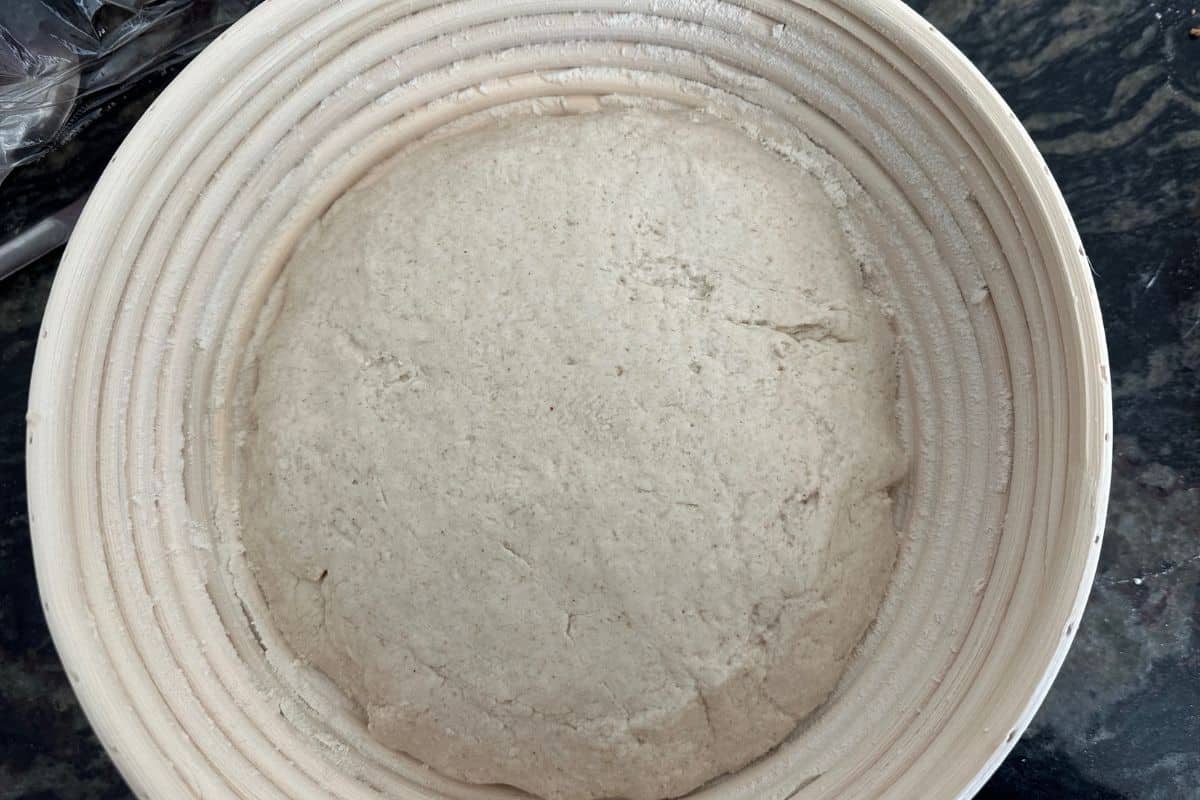
Step 6: Dust the inside of the banneton with flour. This will prevent the dough from sticking to the banneton and getting stuck in the groves. I use brown rice flour since it is less expensive.
If you don’t have a banneton, no problem because you can rise your bread without one if needed. I share those directions below.
Why I recommend a Banneton
- The banneton helps shape the dough into a round or oval form. It gives the loaf a uniform shape and structure. This is particularly important for gluten-free dough with high hydration levels or delicate structures that might spread too much without support.
- Bannetons are usually made of natural materials like rattan, which absorb excess moisture from the dough’s surface during proofing. This helps form a crisp crust during baking.
- The banneton’s coiled texture leaves a beautiful circular pattern on the bread’s surface, giving it a classic boule design.
- They are eco-friendly, easy to clean, and reusable!
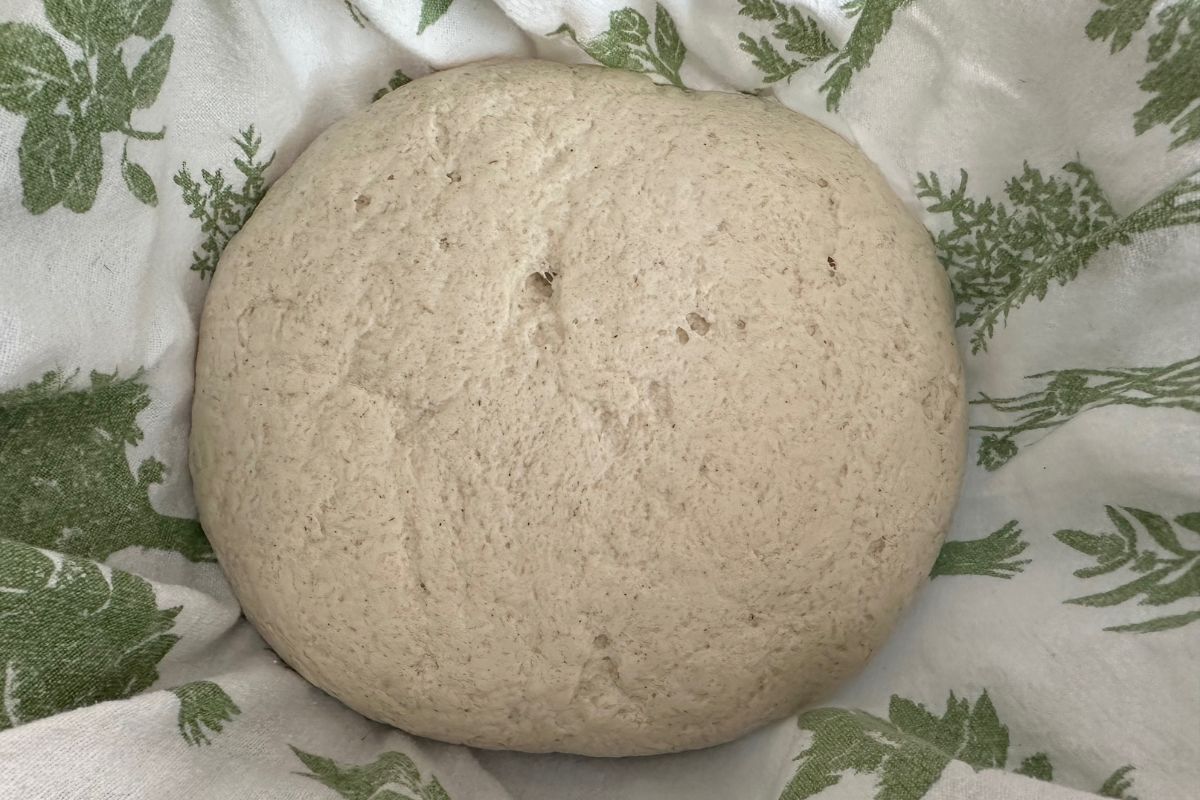
Email This Recipe To Me!
Step 7: Line a
Step 8: Cover the banneton or bowl with plastic wrap and let the dough sit and rise for 4-8 hours until it is close to doubling in size.
What is proofing?
Proofing is considered a “rest period” after mixing up your bread dough so the yeast can ferment. This fermentation creates gases, which is how the bubbles get into your loaf. When you slice your baked bread, you can see the evidence of this fermentation.
How long you proof the dough depends on the season, the temperature in your house, the humidity, and the altitude where you live. I am in the California Bay Area, and our weather really varies. Depending on the time of year, we have a mixture of humid fog, cold, hot, and dry weather here.
Most times, I proof my dough on my counter. You can also proof the dough overnight in the refrigerator. In the cold winter months, I preheat my oven to 175ºF and then turn off the oven. This creates a nice, warm environment that encourages the yeast to ferment. I also like to do a cold proofing for about 2 hours in the fridge during the summer.
Step 9: Preheat the oven to 475ºF. If you are using a Dutch oven (recommended), place it empty with the lid on into the oven as the oven preheats. You want your Dutch oven to be very hot, so let it sit in the oven for about 10-15 minutes when it is 475ºF.
If you will bake your bread on a
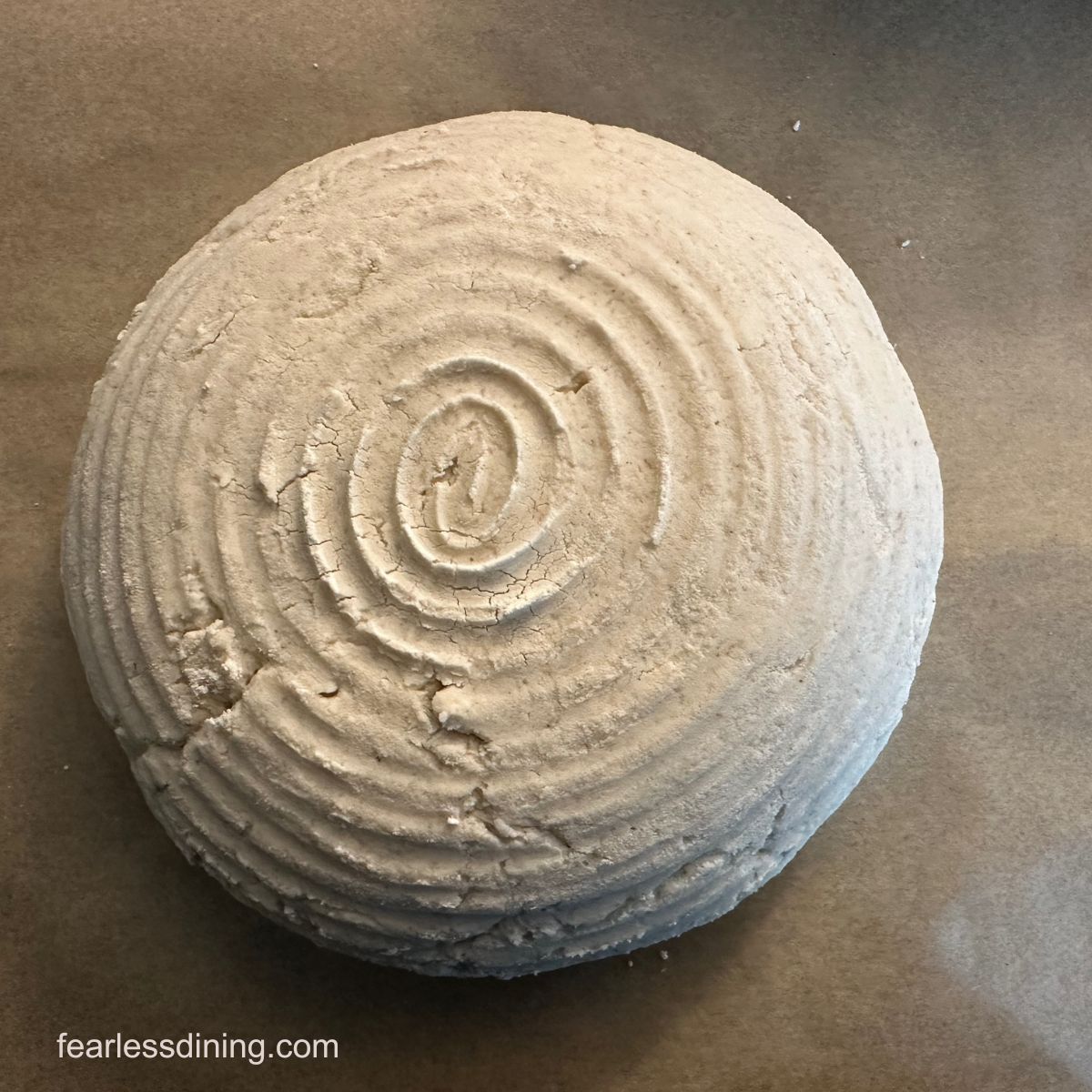
Step 10: If you have used a banneton or bowl, carefully invert it so the dough can fall gently onto a piece of parchment paper. Proper shaping is important so your bread can have good spring and structure. This round shape is called a boule. If you use a banneton, your dough will have a pretty circular pattern on top. Using a bowl, your dough will have a smooth surface like the photo below.
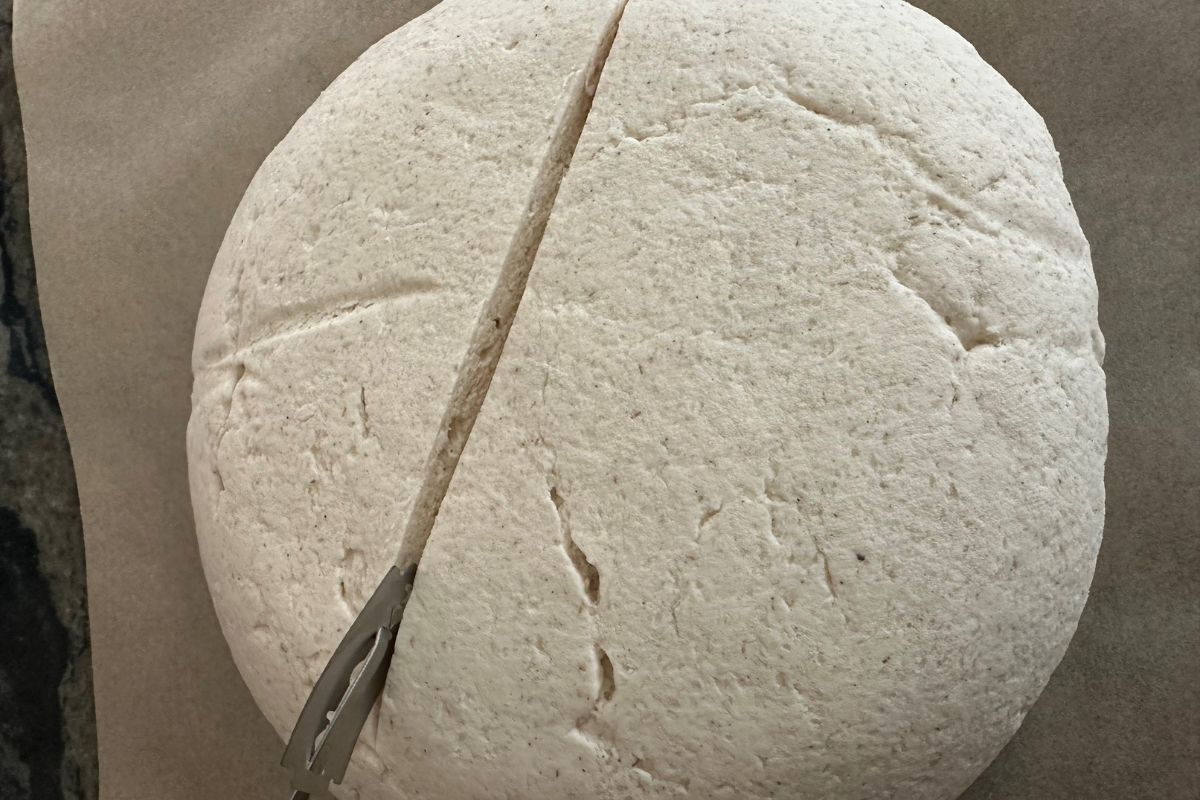
Step 11: Use a bread lame or very sharp knife to make a half-inch deep cut on the top of the bread. You can get fancy and make a pattern if you like. I kept it simple on this loaf, but I will have more sourdough recipes that have different patterns and flavors on the blog soon.
Why do we score the top of the sourdough before baking?
Scoring the top of the bread dough with a bread lame just before baking lets you control how the bread expands during baking. It also gives the bread a pretty look…you can get as artistically creative as you like. Just be sure not to go too deep with your scoring.
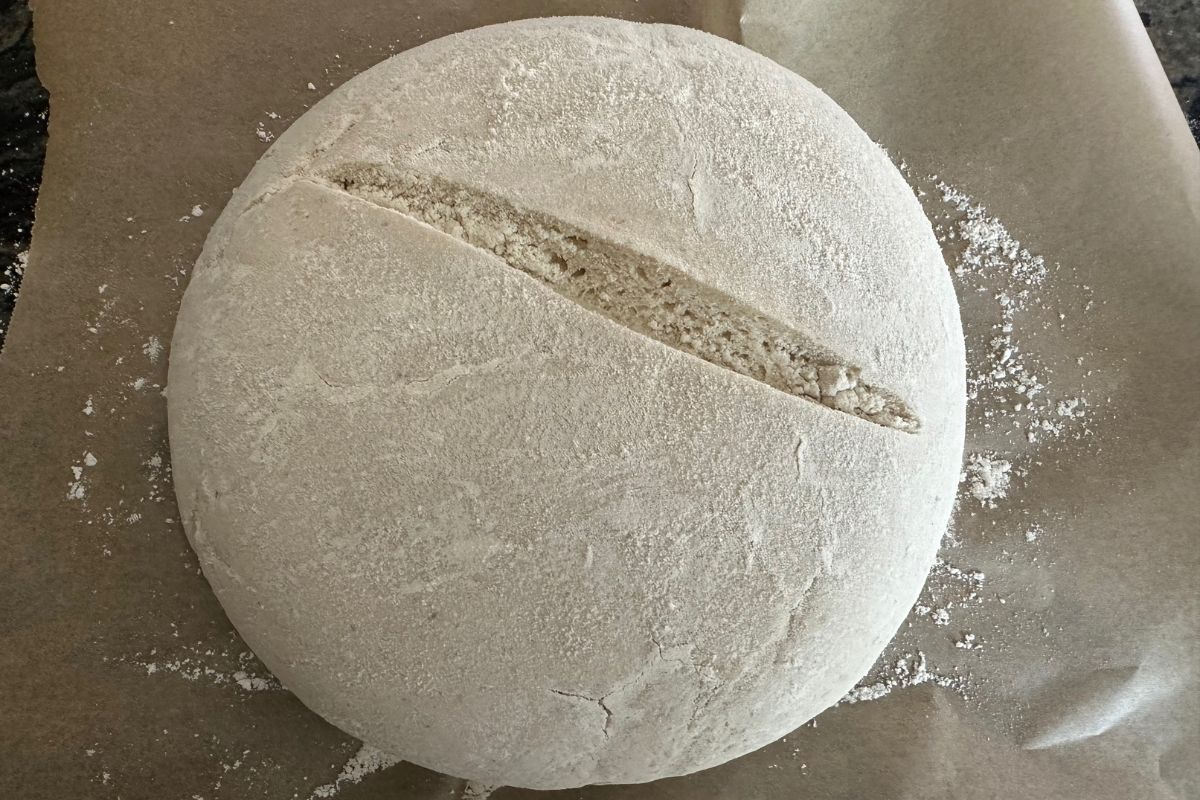
Step 12: Dust your boule dough with flour. I used brown rice flour, which is less expensive than a blend with multiple flours.
Dutch Oven or Baking Sheet Directions:
Step 13 Dutch Oven: Put on thick oven mitts and remove the Dutch oven from the oven. Lift the lid and pick up the boule and parchment paper. Gently place it into the Dutch oven. Put the lid on and put the baking dish back in the oven. The Dutch oven will create the needed steam, so you do not need to do anything else.
Step 13 Baking Sheet: If you use a baking sheet, place an empty pan on the bottom rack of the oven and a baking sheet on the middle rack. Let these get hot while the oven preheats. When you are ready to bake, add several ice cubes to the pan on the bottom rack. Close the door. Remove the baking sheet and put the dough on the parchment paper onto the baking sheet. Place it in the oven quickly so too much heat doesn’t escape.
Why is steam important?
Creating steam in the oven during the initial stages of baking helps the sourdough bread rise and develop a crispy outer crust. The Dutch oven traps the steam from the bread as it cooks, and if you use a baking sheet, a pan of ice cubes will give you the steam you need.
Step 14: Start the baking at a high temperature (475º F), then reduce the temperature to 450º F after the first 20 minutes of baking. This will give the bread time to bake through without burning.
Step 15: After the first 20 minutes, put on your oven mitts and carefully remove the Dutch oven lid or the pan of melted ice. Be careful of hot steam. The ice cubes will have melted, and the water in the pan will be very hot. (You only need the steam at the beginning of the bake, so it is important to remove the steam source.)
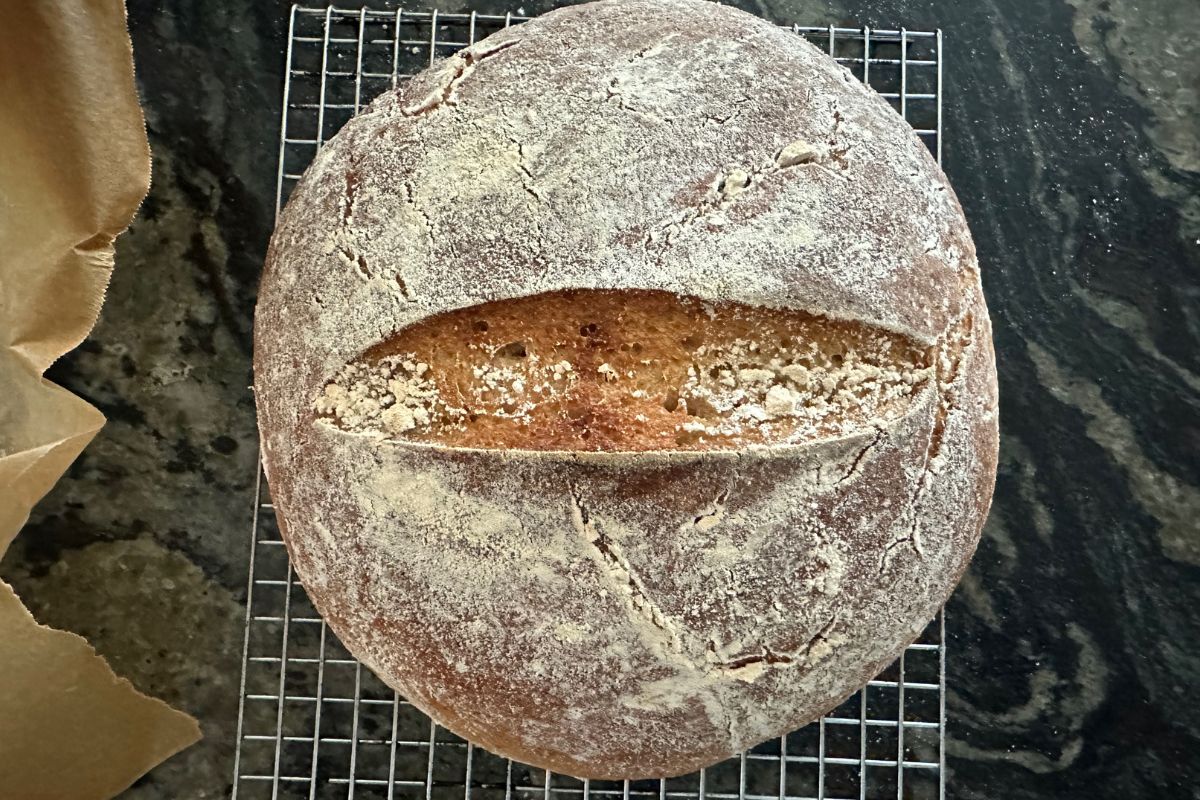
Step 16: Bake the bread for an additional 40 minutes. When the loaf is finished baking, it should have an internal temperature of 210º F. Use a digital food thermometer to check the temperature.
🔑 Sandi says: If the thermometer has a trace of sticky dough, do not worry. This is normal because the inside of the loaf continues to bake while it cools.
Another helpful way to check to see if the bread is finished baking is to tap the bottom of the loaf; it should sound hollow when fully baked. You may also love this Gluten Free Cranberry Walnut Sourdough!
Don’t rush to cut the bread!
This wheat-free sourdough is the best sourdough gluten-free bread, and to enjoy it at its best, you must wait until your loaf is fully cooled and rested before slicing it. I know it is hard, and this will test your patience. Yes, your house will smell incredible, but trust me when I say to wait. I recommend waiting 4-5 hours before cutting your bread. Waiting overnight is even better.
Cooling the loaf is so incredibly important. Allow the bread to cool completely on a wire rack before slicing. Cooling and resting will help prevent the bread from becoming gummy and allow the sourdough flavors to fully develop. So worth it!!
Storage/Freezing Instructions:
Store your sourdough in an airtight container. It will keep fresh for up to 4 days. Note that in hot summer, storing it in the refrigerator is best so the humidity doesn’t cause the bread to mold quickly.
I prefer to slice and freeze the sourdough. Once fully cooled, place the slices in a freezer-safe zipper bag and freeze in the microwave or toaster.
Frequently Asked Questions:
If your sourdough has a gummy interior, chances are you either need to bake it longer or needed to let the loaf cool a lot longer.
If your starter isn’t bubbly after feeding it, it may be cold, or the yeast didn’t survive. Look at the sourdough. Do you see mold or smell something off? If the starter is cold, put it in the oven with the oven light on for a little warmth. Does this help revive the bubbles?
If your sourdough is flat after baking, how long did you let it rise? Did the dough grow in size? Also, check to ensure your oven runs true to the listed temperature. You can buy an inexpensive oven thermometer to check it.
If your top crust burned, it could have been too close to the top of the oven. If the bottom of the crust is burned, it couldn’t be too close to the bottom. I recommend keeping the rack in the middle of the oven. Another cause of a burnt crust is if you baked the bread for too long.
Fact vs. Fiction: Is Sourdough Gluten-Free?
There is some bad advice out there about regular sourdough starters and bread. Many ask online forums if sourdough has gluten. Some inaccurate folks answer that regular sourdough is gluten-free. Regular sourdough is NOT gluten-free. Here are the FACTS:
1. Gluten does NOT burn off or “ferment” out of regular sourdough starter. This is a myth.
2. Sourdough made with wheat flour in Europe is NOT gluten-free. It doesn’t matter if the proteins in European wheat are different and not genetically modified as in the U.S.A. It is still wheat and will damage your gut if you have Celiac Disease.
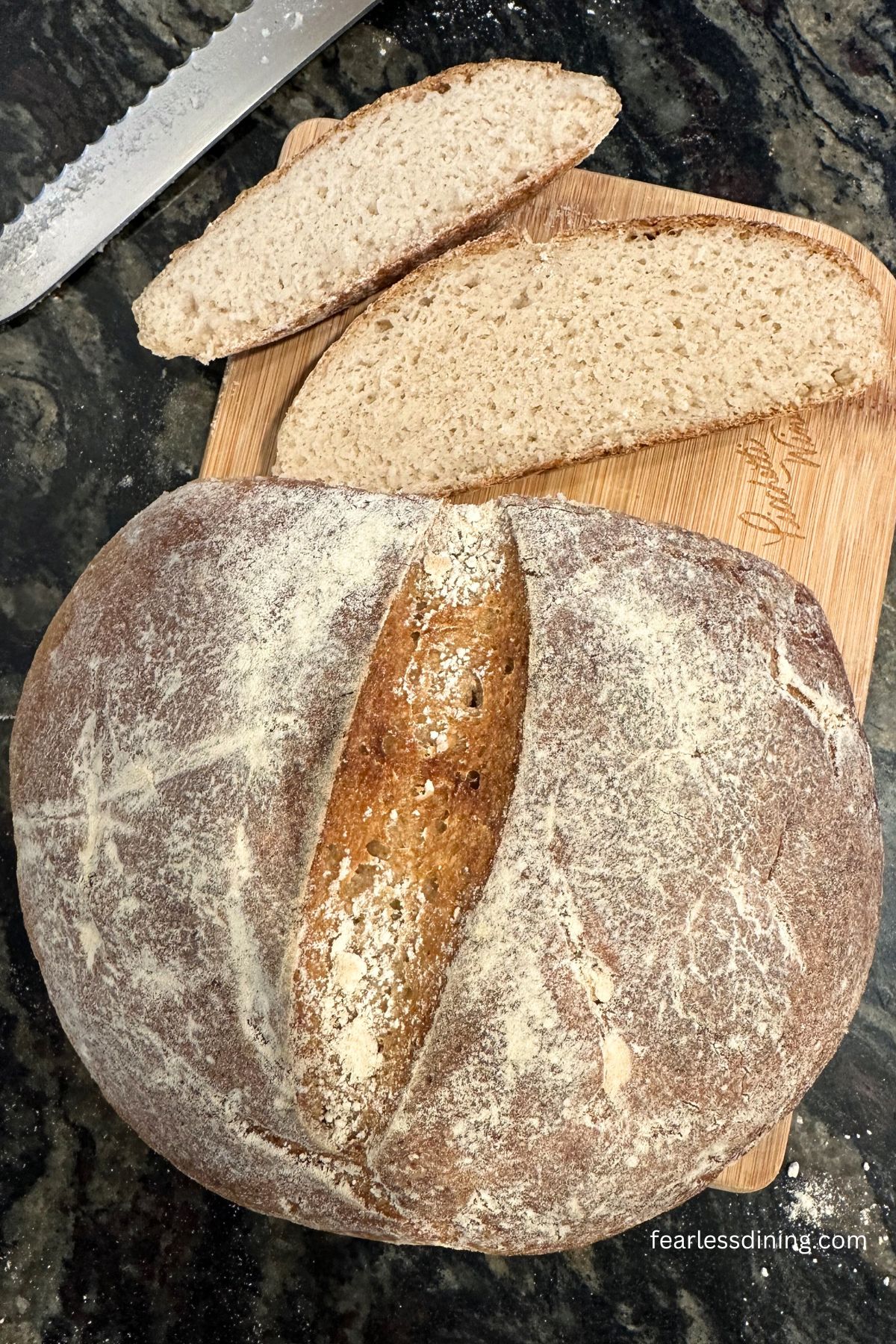
More Gluten-Free Sourdough Recipes:
- Gluten-Free Sourdough Pizza Crust
- Gluten-Free Sourdough Bagels
- Easy Gluten-Free Sourdough Discard Crackers
- Flaky Gluten-Free Sourdough Discard Biscuits
- Gluten-Free Lemon Quick Bread with Sourdough Discard
Love This Recipe?
If you made and enjoyed this recipe, I would be incredibly grateful if you could leave a comment below. Please include which flour blend you used. This helps others know this recipe is delicious. Thank you!

Artisan Gluten Free Sourdough Bread
Ingredients
Method
- Measure out 18 grams psyllium husks on a digital kitchen scale. Place the husks into a small mixing bowl.
- Take out ¾ cup sourdough starter from your jar and set it aside. See the NOTES below if you keep your starter in the fridge!
- Pour 1 ½ cups purified water, purified water into the bowl of dried husks. Use a spoon to stir it. It will form a gel in about 2-3 minutes.
- Measure 488.5 grams gluten-free flour blend. It is important to note that every flour blend has a different starch-to-grain ratio. I have successfully tested this sourdough boule recipe with all four of my homemade gluten-free flour blends.
- Add the flour to a large mixing bowl. Add 1 teaspoon sea salt and use a whisk to blend them together. Add 3/4 cup of sourdough, the psyllium gel, and 1 cup purified water to the flour in the bowl. (Note: Use more salt if you like a saltier loaf.)
- Mix the ingredients together with a large wooden spoon. Once they are mostly mixed, you will have a rough-looking dough. Wash your hands and use your hands to further squeeze and mix the dough together until you have a well-hydrated, tacky dough ball. It shouldn't be too sticky.
- Dust the inside of a banneton with flour. This will prevent the dough from sticking to the banneton and getting stuck in the groves. I use brown rice flour since it is less expensive.
- If you don't have a banneton line a mixing bowl with a clean kitchen towel. Place the dough in the towel.
- Cover the banneton or bowl with plastic wrap and let the dough sit and rise for 4-6 hours until it is close to doubling in size.
- Preheat the oven to 475º F. If you are using a Dutch oven (recommended), place it empty with the lid on into the oven as the oven preheats. You want your Dutch oven to be very hot, so let it sit in the oven for about 10-15 minutes when it is 475º F.
- If you have used a banneton or bowl, carefully invert it so the dough can fall gently onto a piece of parchment paper. Proper shaping is important so your bread can have good spring and structure. If you use a banneton, your dough will have a pretty circular pattern on top. Using a bowl, your dough will have a smooth surface.
- Use a bread lame or very sharp knife to make a half-inch deep cut on the top of the bread. You can get fancy and make a pattern if you like. I kept it simple on this loaf, but I will have more sourdough recipes that have different patterns and flavors on the blog soon.
- Dust your boule dough with flour. I used brown rice flour, which is less expensive than a blend with multiple flours.
- Dutch Oven: Put on thick oven mitts and remove the Dutch oven from the oven. Lift the lid and pick up the boule and parchment paper. Gently place it into the Dutch oven. Put the lid on and put the baking dish back in the oven. The Dutch oven will create the needed steam, so you do not need to do anything else.
- Baking Sheet: If you use a baking sheet, place an empty pan on the bottom rack of the oven and a baking sheet on the middle rack. Let these get hot while the oven preheats. When you are ready to bake, add several ice cubes to the pan on the bottom rack. Close the door. Remove the baking sheet and put the dough on the parchment paper onto the baking sheet. Place it in the oven quickly so too much heat doesn't escape.
- Start the baking at a high temperature (475º F), then reduce the temperature to 450º F after the first 20 minutes of baking. This will give the bread time to bake through without burning.
- After the first 20 minutes, put on your oven mitts and carefully remove the Dutch oven lid or the pan of melted ice. Be careful of hot steam. The ice cubes will have melted, and the water in the pan will be very hot. (You only need the steam at the beginning of the bake, so it is important to remove the steam source.)
- Bake the bread for an additional 40 minutes. When the loaf is finished baking, it should have an internal temperature of 210º F. Use a digital food thermometer to check the temperature.
- This wheat-free sourdough is the best sourdough gluten-free bread, and to enjoy it at its best, you must wait until your loaf is fully cooled and rested before slicing it. I know it is hard, and this will test your patience. Yes, your house will smell incredible, but trust me when I say to wait. I recommend waiting 4-5 hours before cutting your bread. Waiting overnight is even better.
Nutrition
Notes
- If you use my gluten free flour blends to make sourdough, it is important to omit the psyllium husk powder when mixing the blends. I use psyllium husks in my sourdough recipes. Psyllium husks are superior to psyllium powder in giving sourdough the right crumb and texture. Check out my gluten-free flour blend recipes.
- 8/18/24 Update: I tested this recipe with Namaste Gluten-Free Flour Blend and it worked well. You will need 1/4 to 1/3 cup of additional purified water. Start with 1/4 cup and add more if needed.
- I always use purified water when making sourdough or baking with yeast. Chlorine and chemicals in our tap water can kill your yeast and inhibit the rise. If you want the best rise, you must use purified water that doesn’t contain these chemicals.
- Store your sourdough in an airtight container. It will keep fresh for up to 4 days. Note that in hot summer, storing it in the refrigerator is best so the humidity doesn’t cause the bread to mold quickly.
- I prefer to slice and freeze the sourdough. Once fully cooled, place the slices in a freezer-safe zipper bag and freeze in the microwave or toaster.
- Ensure your sourdough starter is healthy and active. If you store your sourdough in the refrigerator, take it out and feed it before making bread. Let it warm to room temperature before using it.
- If the starter is not rising well or has a foul smell, consider refreshing it with equal parts flour and water and allowing it to ferment at room temperature until bubbly and active.
- If a clear liquid is on top of the starter, it is called a hooch, and you should drain it off. This hooch is a sign that your starter is hungry and needs to be fed.
Nutritional Disclaimer
Nutritional information is an estimate provided to you as a courtesy. You should calculate the actual nutritional information with the products and brands you are using with your preferred nutritional calculator.
Tried this recipe?
Let us know how it was!
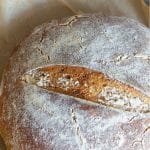
Quick question. You list using two tsp of salt in your list of ingredients, however in your instructions you only use one tsp of salt, in fact you state “Add a teaspoon of 2 teaspoons sea salt and use a whisk to blend them together”. What are we to do with the Other teaspoon of salt?
Thanks for clearing this up for me!
Hi Bobby, Use one teaspoon please. Some noted the recipe needed more salt, but I tested it recently and disagree. I updated this to be more clear.
Hello
When making cuts with a lame, do you dust with flour before or after making the cuts?
Hi Marybeth, I make my cut with the lame after dusting the loaf.
Made this one today (started yesterday). Bakes up beautifully, but I found I needed to add a little more salt and bake it for an extra 10min. Might just be my oven.
Delicious!
I am so glad you loved this sourdough, Kris. Thank you so much for coming back to let me know. I am really glad you noticed you needed to bake yours longer.
Do you still do the stretch and folds to the dough?
Hi Deb, Gluten free doesn’t have the same proteins, so you don’t need to stretch the dough. I often will fold it just so it makes a nice round shape.
New to baking! I’ve tried your recipe a few times with King Arthur gf, and the inside has been soft, but the crust so hard and thick. I just went and bought a bunch of flours so I can make one of your blends instead, and I’m wondering if it would make any difference also to let the preferment sit overnight—and then add the main portion of the flour the next day (I hope I’m using the terminology right!) I’ve seen something along those lines for other recipes, and was surprised it wasn’t present here, as well, so I thought I’d ask the expert!
Hi Hannah, which gluten free King Arthur flour? Their measure for measure doesn’t really work in yeast recipes. I can’t test their bread flour because it is made with wheat starch. This is technically gluten free, but still makes me sick. I use the method you describe in my sourdough sandwich bread, but I haven’t needed to do a long overnight rise with this recipe.
Hi sandy
Do you have a recipe using your flour blend to make just artisan bread not sourdough bread?
Ruth
Hi Ruth, this has been on my list, but the summer has been so hot and I now we are in another huge heat wave. I will work on a non-sourdough artisan bread recipe as soon as it cools off.
This was the BEST sourdough flavor! I’ve been trying recipes for several months now, and this one filled the bill. I feel like I’ve finally landed. I used the sorghum-free flour blend from the notes. The boule was super simple to make, and turned out so beautifully and delicious. I’ve eaten a quarter of the loaf this morning! Thank you, Sandy, for your hard work in developing these delicious recipes.
I am so glad you loved this recipe!! Thank you so much for the photos you sent to me to show me your bread. I loved seeing them!
What can be used in place of the psyllium? I am allergic to it.
Hi Lori, you can use 1 teaspoon of xanthan gum in place of the psyllium.
Thank you!
You are very welcome!